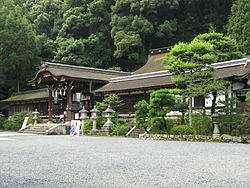Matsunoo Shrine
| Matsunoo-taisha 松尾大社 |
|
|---|---|

The haiden, at Matsunoo-taisha
|
|
| Information | |
| Dedicated to |
Ō-yamagui-no-kami Nakatsu-shima-hime-no-mikoto Tsukuyomi |
| Founded | 701 |
| Address | 3 Arashiyamamiya-chō, Nishikyō-ku, Kyōto-shi, Kyōto-ken 〒 616-0024 |
| Website | www |
|
|
|
Matsunoo-taisha (松尾大社 "Matsunoo Grand Shrine"?, formerly Matsunoo-jinja 松尾神社) is a Shinto shrine located at the far western end of Shijo Street, approximately 1.3 kilometers south of the Arashiyama district of Kyoto, Japan. It is home to a spring at the base of the mountain, Arashiyama, that is believed to be blessed.
It is said that during the move of the capital from Nara to Kyoto, a noble saw a turtle bathing under the spring's waterfall and created a shrine there. It is one of the oldest shrines in the Kyoto area, its founding extending back to 700 AD. The restorative properties of the spring bring many local sake and miso companies to the shrine for prayers that their product will be blessed.
The shrine also serves a kinpaku (gold leaf filled) miki (or blessed sake) during hatsumode.
The shrine became the object of Imperial patronage during the early Heian period. In 965, Emperor Murakami ordered that Imperial messengers were sent to report important events to the guardian kami of Japan. These heihaku were initially presented to 16 shrines including the Matsunoo Shrine.
From 1871 through 1946, Matsunoo-taisha was officially designated one of the Kanpei-taisha (官幣大社?), meaning that it stood in the first rank of government supported shrines.
...
Wikipedia
